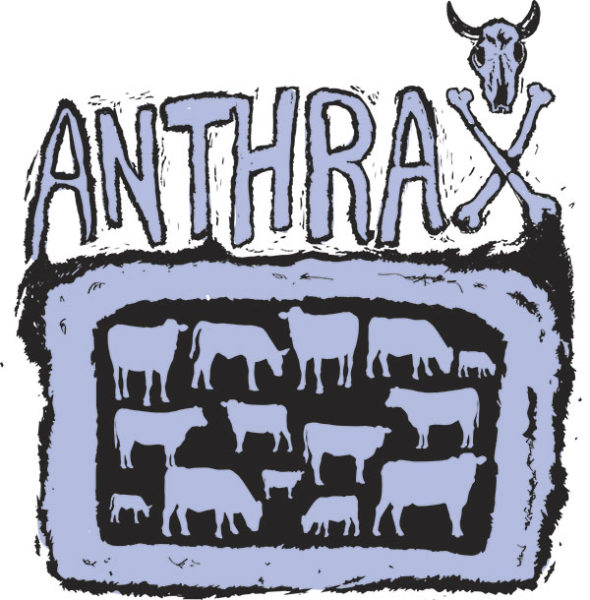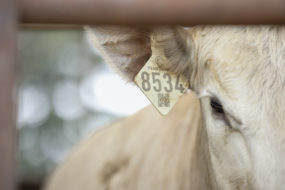The zoonotic disease, a universal threat, warrants concern and vigilance from beef producers everywhere.
Anthrax, caused by the bacteria Bacillus anthracis, can be fatal to humans and many animals through rapid septicemia (infection of the bloodstream). Cattle most commonly pick up the disease by ingesting or inhaling the bacterial spores while grazing. Humans can contract the disease through cutaneous (broken skin barrier) infection, inhalation or ingestion. Biting insects can also be vectors as they transmit contaminated bodily fluids from one host to another.
“In Texas, the spring and early summer of 2019 was cooler and had much more rainfall than usual. In addition, heavy rains can cause bacterial spores which are present deep in the soil to float to the surface, making them more easily ingested by grazing animals,” explains Dr. Amy Swinford, DVM, associate director and veterinary microbiologist of the Texas A&M Veterinary Medical Diagnostic Laboratory. “Wet weather also increases the fly populations. Flies which feed on an infected carcass can spread the bacteria to other animals.”
Anthrax usually transfers from human to cattle cutaneously during handling of infected animals or carcasses. While still a serious illness which warrants medical treatment, this form is less likely to become fatal compared to inhalation or ingestion. Nevertheless, caution should always be taken when examining carcasses or live animals suspicious for infection.
Managing the risk
As a general rule of thumb, anthrax outbreaks like to happen after periods of cool and wet weather followed by dry conditions. The states which see regularly see the most outbreaks are Texas, North Dakota and South Dakota, but other states are also at risk. In certain Texan regions and counties, anthrax is considered to be endemic.
“Anthrax spores can survive in the soil for decades. They prefer high-pH, calcareous, nitrogen-rich locations with ambient temperatures above 60 degrees Fahrenheit,” says Dr. Rick Machen, a professor at the King Ranch Institute for Ranch Management. He has lived and worked in an endemic region where outbreaks have been very common for over 75 years. “Fortunately, anthrax is very slow to ‘escape’ or spread from the endemic areas, so location of outbreaks is very predictable.”
Anthrax, being a reportable disease, is handled by the correlating state agency. In Texas, that agency is the Texas Animal Health Commission (TAHC). Once anthrax is confirmed by a veterinarian and/or diagnostic lab, the case is monitored and handled carefully. This typically includes quarantining the property and restricting the flow of animals to or from the area.
One of the major actions TAHC takes is to help livestock managers to properly dispose of infected carcasses. This must be done in a way which destroys spores and prevents further spread of the disease from body fluids leaching into the soils, typically accomplished by careful, controlled burning. Contaminated soils not only affect cattle grazing, but also other wildlife populations.
If any dead animals found are suspected to be contaminated, caution must be taken to test for the disease.
“Livestock managers should not handle dead animals,” Machen cautions. “A recommended method of sample collection is to wear plastic gloves, remove an ear from a suspect carcass, place it in a sealable bag and deliver to a veterinarian immediately. Thoroughly disinfect the knife used. Carcasses should not be disturbed or dissected.”
Swinford says she believes education of both ranchers and veterinarians on the symptoms and risk of the disease is key. It is good practice for cattlemen to be aware of the land they graze and if there was any history of anthrax cases. In such a case, all animals should be vaccinated as a precaution.
“In areas of the state where anthrax has been reported or is known to occur, vaccination of animals prior to an outbreak is highly successful in preventing death losses,” she says.
Machen adds, “The vaccine is readily available, inexpensive and very effective if given at least 21 days prior to exposure. Vaccinate all livestock annually, including horses and other grazers, preferably four to six weeks prior to expected and/or historic anthrax outbreak periods.”
Hope for treatment?
While anthrax in cattle is preventable, treatment seldom gets there fast enough nor is it often successful.
“Unfortunately, in endemic areas, the disease often strikes with little warning,” says Swinford. “Once infected, animals develop symptoms within three to seven days, and die within 48 hours of the first signs of disease.”
She added the usual symptoms may include high fever, staggering, seizures, difficult breathing, depression, and blood coming out of body orifices. In most cases, anthrax is so fast-acting animals are not observed to be ill before being found dead. Those who graze on the open range will rarely observe cattle frequently or long enough for successful diagnosis and treatment. Smaller-scale operations may be able to monitor daily for the symptoms and begin treatment at the first sign.
“Penicillin and related antibiotics can effectively treat an infection, but because death occurs so rapidly after the first signs of illness, it can be difficult to treat animals which are already infected,” she says. “Also, treatment with antibiotics interferes with vaccination, so animals that are vaccinated should not also be given antibiotics.”
For those who live in endemic areas, or any area which has a history of anthrax cases, the threat always looms perennially. As the weather cools down, risks may subside for some months, but contaminated soil can’t so easily be declared “clean.”
“Once infected, long infected,” says Machen of infected land. “Spores can remain viable for decades in the soil.”
He says wildlife, such as scavengers feeding on contaminated carcasses, can help spread the bacterial spores. So even pastures which never had a history of infected cattle can become contaminated due to wildlife activity.
With preventative medicine and a knowledgeable team of individuals including veterinarians, cattlemen and educators, working cattle in conditions and areas favorable to anthrax is not a death sentence. Proper precautions and protocols in place will help make the best of these situations. ![]()
ILLUSTRATION: Illustration by Corey Lewis.
Jaclyn Krymowski is a freelancer based in Ohio.








